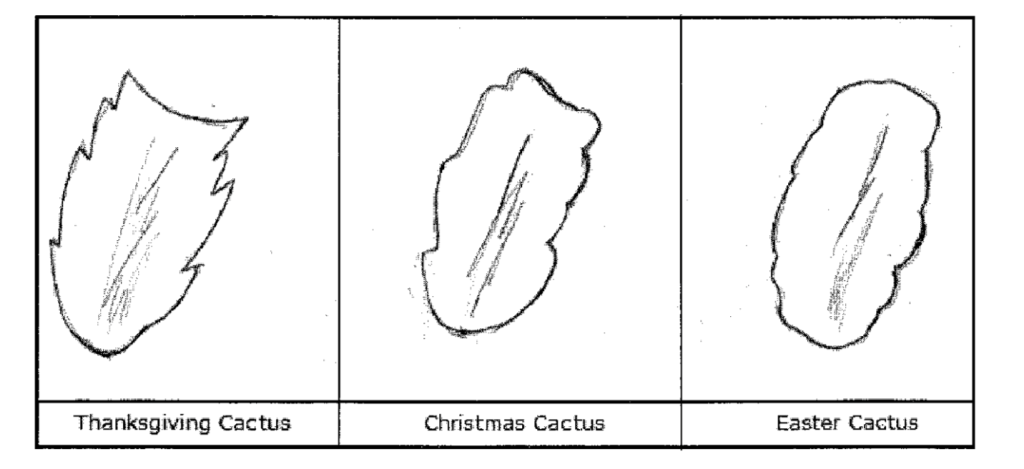Tis the Season… for Christmas Cacti
Many years ago, a lonely Jesuit priest traveled the rainforests of Brazil, striving to share his faith with the indigenous peoples of the forests. One Christmas Eve, feeling very alone, downhearted and discouraged that he had gained few converts, he prayed to God at a humble altar. Suddenly he heard the beautiful voices of young children to whom he had taught a hymn. Turning around, he saw a procession of these children heading to the chapel, singing, and carrying lovely sprays of the brilliant red flowers of the Christmas cactus.
So goes the legend associated with the Christmas cactus. It is true that the Christmas cactus, as well as the closely related Thanksgiving and Easter Cacti, are native to Brazil. There, they are epiphytes in that they do not send roots into the ground, but rather depend upon rocks, shrubs, or trees for their support. (Imagine, if you can, those youngsters shimmying up tall trees to gather these blossoms for the priest!). However, in our northern hemisphere, we pot them up in soil and maintain them as long-lasting houseplants that dazzle our senses during the cold holiday season with glorious blooms.
One question we frequently are asked is what the difference is between the various holiday cacti. The easiest way to recognize the difference is to examine the shape of the leaf segments and to note the season of bloom.
Thanksgiving cacti (Schlumbergera truncata and S. russelliana) are sometimes called crab cacti because the leaves have toothed or crab claw-like points along the sides. They begin to flower in late autumn and may continue to do so into December.
The leaves of Christmas cacti (referred to either as Schlumbergia xbuckleyi or S. bridgesii) have more rounded edges and bloom four to six weeks later than the Thanksgiving cacti – too late for our Christmas season. Having said that, what often are labeled as Christmas cacti are more than likely a hybrid of Thanksgiving cacti in order to ensure they bloom at Christmas for you.
Generally, you will see fewer Easter cacti (Hatiora gaertneri) than the others, but if you have the opportunity to obtain one, they bloom profusely with delicate star-like flowers in early to mid spring. The edges of the leaves of the Easter cacti are closer in appearance to Christmas cacti, but even smoother.
Like Poinsettias, all holiday cacti are short day plants, in that they need fewer hours of daylight to develop blossoms.

One interesting note is that the genus of the Thanksgiving and Christmas cacti formerly ways Zygocactus, but was renamed Schlumbergera some time ago. However, they still often are referred to Zygos.
How to care for your Holiday Cacti
Although holiday cacti are succulents, they are not like the variety of cacti that you will find in hot, arid desert.s. Instead, they are tropical succulents and enjoy ambient humidity. While they prefer well-drained soil, they can use a thorough watering during the spring and summer, but less water once the fall begins. Let the soil dry out a bit between waterings. Use the standard knuckle test: Push your index finger into the soil up to the second knuckle. If your finger comes out dry, it is time to water. Never let them sit in a water filled saucer or cache pot as that can lead to root rot.
Holiday cacti thrive in bright, indirect light and will bloom profusely in that environment. Avoid direct sunlight-that will only burn the leaves. Try to imagine them in their natural habitat-flourishing under a sun filtered canopy of leaves in that tropical rainforest that drips with humidity.
As with most houseplants, these cacti should be fertilized during their active growing season, spring and summer in our hemisphere. Use a standard fertilizer with a balanced nitrogen, phosphorous, potassium mix, such as 10-10-10.
Like many houseplants, Christmas cacti enjoy being somewhat root bound, so do not be in too much of a hurry to report your plants. When it becomes necessary, only repot after they have finished blooming and only move up one pot size. For example, if your cactus is in a six inch diameter pot, replace that with one that is no more than one or two inches larger.
Concerns
Generally, Christmas cacti are quite easy to grow and maintain. Customers have told me that they successfully have grown theirs for decades. However, if your cactus seems to be flagging, there are a number of potential concerns to consider.
If your cactus is not blooming, perhaps it is getting too many hours of light. As winter approaches, try to find a cool spot in your home that is not exposed to more than twelve hours of natural or artificial light per 24 hour period. If necessary, extend that period of darkness by placing your plant in a closet or under a box.
If the leaves have a reddish tint, your plant may have been over watered and is suffering from root rot. The red may also indicate a lack of appropriate nutrients, or it could be sunburned, especially during the summer when the sunlight is harsh.
Check closely for pests, particularly mealybugs and spider mites. Mealybugs hide in leaf axils, that is, where the leaf meets the stem. They look like tiny, white pieces of cotton fluff, but are more sinister in that they can suck the juices out of a plant. Mealybugs leave a sticky residue, which can attract ants especially if your cactus spends the summer outside.
Spider mites are tiny, too-small-to-see-with-the-naked-eye red arachnids that, like mealybugs, suck the life out of plants. Check for webbing on or in between the leaves or for yellow mottling on the leaves.
Both of these pests can be treated by spraying with insecticidal soap, which is an organic pesticide, or with 70% isopropyl alcohol. They are persistent vermin, so be diligent!


